![]()
![]()
![]()
![]()
![]()
![]()
![]()
![]()
![]()
![]()
![]()
![]()
![]()
![]()
![]()
![]()
![]()
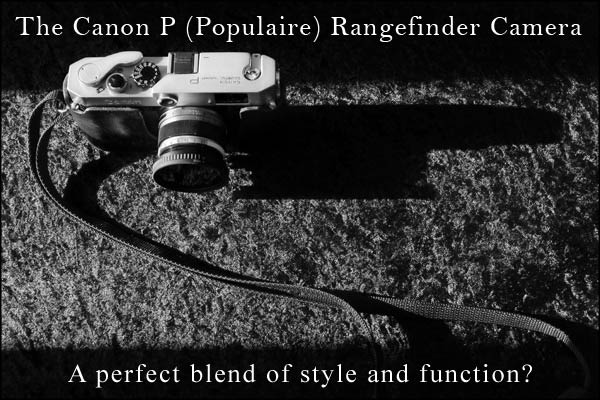
![]()
The Canon P (for Populaire)... This camera feels like it has become
part of my 'photographic soul' over the few years I've owned one, an
artistic partner and favourite of mine to use, especially for making
street and documentorial images. So, as people occasionally ask about
the cameras I use, I thought I'd talk a little about this one in particular...
![]()
Firstly, and although it doesn't really matter, I feel it needs to be
said... the Canon P is one beautiful looking camera! In my opinion only
the Leica Ms match it for style. It is fair to say during the 1950s
Canon took a leaf out of Leica's design book. The Leica M3, released
in 1954, was proving to be hugely successful, and Canon's similarly
sized series V and VI ranges from 1956 onwards definitely jumped on
those style ideas, the flat top-plate form in particular, a simple,
timeless, iconic look. Great design doesn't grow old, and Canon can
thank Leica for that.
![]()
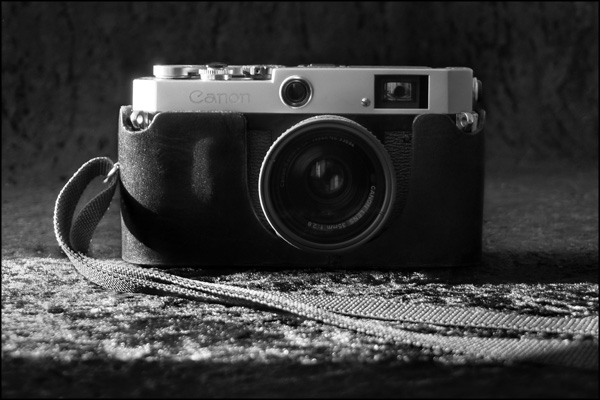
![]()
It is a camera almost entirely made of metal so it can take a knock
but even so, I always like to use it with a half-case for a little extra
protection to the body. The images above show the leather half-case
I made for it in 2016. Incidentally, I continue to make cases for other
owners in my spare time (including for some Leica and Nikon cameras
too) under the Mr
Brizzles label. Some people comment they prefer how the case gives
the Canon P a rounded form (much like a Leica).
![]()
The Canon P was made between 1959-1961, in direct competition with the
Leica M3 and M2, and became Canon's best selling camera at the time.
I believe the manufacturing quality to be a match for those Leicas too.
There's a wonderful surety to the moving parts and a feeling of mechanical
precision throughout, like all Canon rangefinders made to this point
in time.
![]()
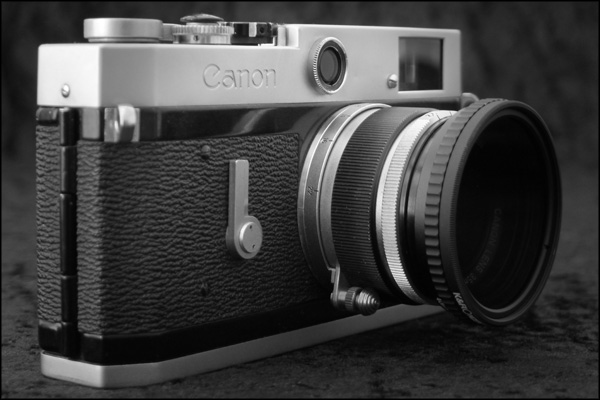
![]()
So, with all the mentions of Leica, is the Canon P a Leica M3 wannabe?
Well, a better comparison might be with the M2 as the M3 doesn't have
35mm framelines. However, although there is much in common, the Canon
P is most definitely a camera with its own distinct spirit. Much of
its design was forward thinking, which had advantages over the Leicas
of the time, perhaps the most obvious being the swing door back, a radical
change from the traditional bottom loading design. Film can be loaded
quickly without needing to remove parts or cut film leaders to a different
shape.
![]()
As the above photo shows, the Canon P has a self-timer, something that
I rarely use, which is why my half-case design covers the lever, offering
extra protection. The timer is a fine example of the mechanical quality
of the camera though... the ticking sound when activated, an unwavering
and precise count-down, projects an air of refinement and reliability.
![]()
Where Leica switched to its new 'M' mount bayonet system for its lenses,
Canon continued to use the old Leica Thread Mount (LTM) system (also
known as Leica Screw Mount, or M39). Although modern lens choices are
fairly limited there is a weath of excellent vintage lenses available,
and Canon's own lenses were regarded as some of the best in the world
at the time, even better than much of the Leica glass. I think those
lenses from the 1950's have a really nice mix of vintage feel and modern
clarity.
![]()
My Canon 35mm f/2.8 lens has a focus tab attached which I love. These
lenses have such a long focus throw I find using the tab helps with
much quicker adjustment.
![]()
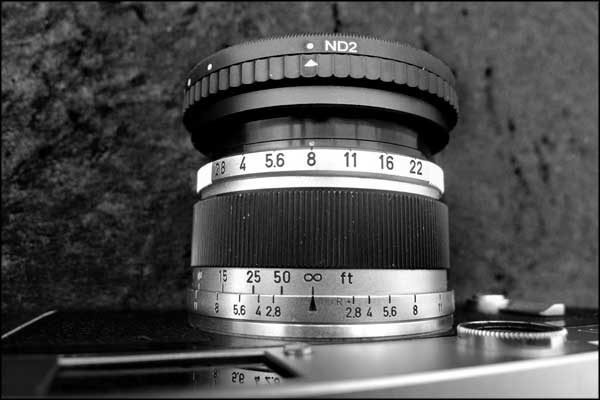
![]()
The markings on some lenses appear off-center when properly attached.
This is usual and enables easier viewing of the settings when a viewfinder
or accessory is attached to the camera's cold shoe.
![]()
I have always liked using ND filters and high ISO film (or digital sensor
rating) to give myself a larger possible exposure range. However, I
find changing filters annoying so I have recently acquired a couple
of 5 stop variable ND filters for my main LTM lenses. I have been impressed
in the past with filters I bought from K&F
Concept directly, and these ND2-32 filters seem really good too.
They are well made and accurate. I even like how the indicator mark
matches up exactly with those of the lens. As this is on a wider angle
lens I have used a bigger filter (with a step-up ring) to avoid vignetting.
![]()
By rating the film (currently Ilford HP5+) at 1600 ISO I can shoot in
lower light conditions and for bright daytime use I can adjust the filter
to a denser setting to keep the shutter speed less than the camera's
maximum. The higher ISO creates an image with higher grain and contast
but that is my preferred look anyway.
![]()
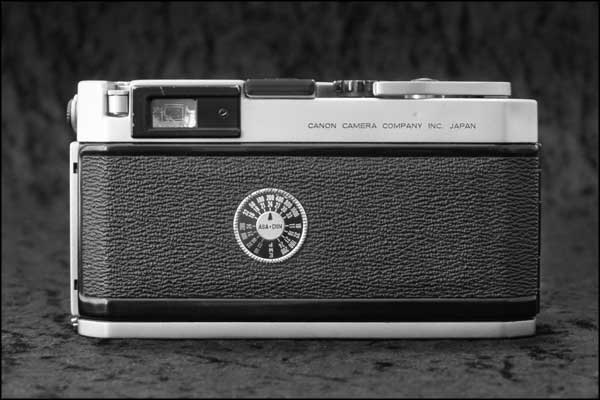
![]()
The ASA/DIN dial on the film door has no purpose other than as a reminder
of the film speed loaded. There is no in-camera lightmeter so the dial
does not link to one as with a typical metered camera... here, the dial
just rotates. I rarely bother to change it.
![]()
The viewfinder has three silvered albada framelines, showing the view
for 35mm, 50mm and 100mm lenses. They move with focusing to automatically
adjust for parallax error... the viewfinder does not see through the
lens so there is always a difference in angle of view (think of the
difference one sees when looking through each eye individually).
![]()
The wonderful thing about this viewfinder is its true 1:1 view. Other
cameras come close, the Leica M3 has 0.92x magnification, the M2 has
0.72x. The 1:1 view means one can compose with both eyes open, the framelines
floating in a true 3D scene. It is a different experience from the usual
2D view, and for me when I shoot this way I feel more connected with
the scene and I can see more outside of the frame too, useful for timing
and reading how a scene may play out.
![]()
The viewfinder does flare a little under more extreme conditions, and
the framelines are sometimes not as easy to see as those in a projected
frameline viewfinder, but it is something one adjusts to, and the view
has 'real world' brightness and excellent clarity. The 35mm framelines
are placed right in the edge of peripheral vision, basically the edge
of the viewfinder view, so I tend not to pay much notice of them...
what I see through the whole viewfinder is essentially what I find ends
up on the film.
![]()
I found there was (is) one drawback with this viewfinder... no in-built
dioptre correction, and Canon's original dioptre adjustment lenses seem
impossible to find nowadays. So, I fashioned my own replacement! The
rear viewfinder lens housing is designed to be removed (a small screw
holds it in place) and the lens to replace is held in the housing by
a small plate and glue... I carefully removed it and filed down the
edges of a replacement dioptre lens... a -2 dioptric adjustment
lens 'S' designed for Canon's A series SLRs. Once the lens was
a perfect match I fitted it into the housing and back in place. A perfect
solution, just a little patience required.
![]()
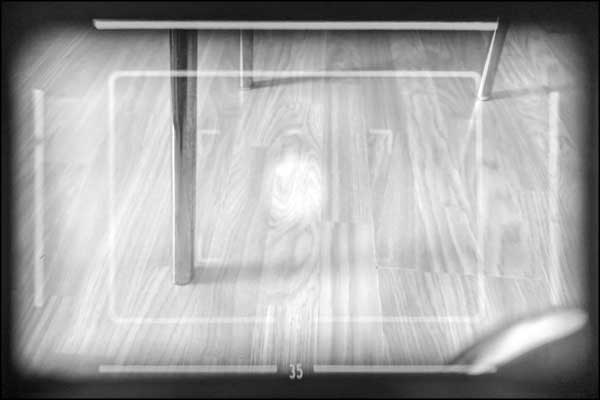
![]()
A closer view of the framelines, and the focusing spot in the center.
The focus spot is a good size and has a soft edge. Some may prefer it
to be more defined. It isn't something that bothers me either way. I
find the Canon P spot quite subtle and natural, blending with the scene
with minimal distraction.
![]()
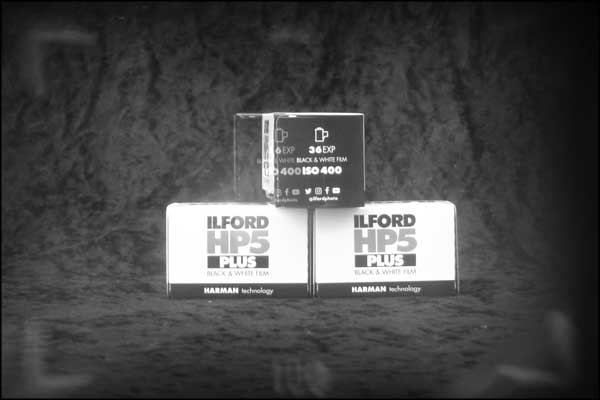
![]()
An even closer view of the focusing spot, which seen here can sometimes
be hardly noticable at all... except for the double image of course.
As with all manual focus cameras (and autofocus cameras too) areas of
higher contrast are the easiest to focus on. In rangefinders, when the
two images are perfectly overlaid then focus is achieved.
![]()
One of the things I like about rangefinder cameras is that the view
is always natural, as opposed to seeing through the lens with SLRs where
out of focus areas appear less sharp. For street / documentary type
photography I really prefer to see the whole scene clear in the viewfinder
all the time.
![]()
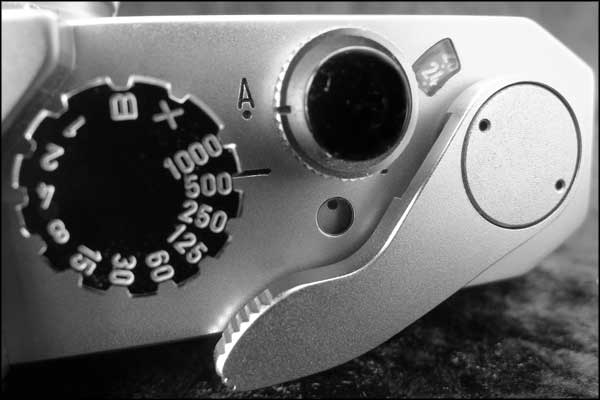
![]()
The Canon P shutter button is threaded to accept a cable release. This
is the only way to lock the shutter open for timed long exposures. It
isn't something I use very often so I usually screw a soft release button
in place, to extend the size of the shutter button and give it a very
slight convex shape. This not only adds a smoother feel but allows me
to trip the shutter with a gentler pressure to the edge of the button.
![]()
Like later Leica cameras the Canon P also has a red dot! It lives in
the small window towards the rear of the shutter button and turns when
the winder lever is actioned. It revolves the opposite way when rewinding
film, stopping when the film comes off the sprockets. A useful indicator.
Around the shutter button is the rewind collar. Turn it to enable the
film chamber sprocket action to reverse before rewinding film.
![]()
The camera can make multiple exposures. A little awkwardly but it works,
and again the little red dot plays a useful role. After the first shot,
turn the collar to the rewind position and rewind the film watching
the red dot... once it has completed a whole rotation (and a little
bit more) switch the collar back to 'A' position (for 'Advance'?) and
wind the film on... the frames will perfectly match.
The camera's quality is particularly felt when using the wind-on lever.
A single long stroke (or multiple smaller strokes) will ready the shutter
and wind the film one frame onwards. The action is smooth and quiet
with no ratchet sound... a very refined feel indeed. There is a frame
counter in front of the lever. This resets automatically whenever the
camera back is opened.
![]()
The shutter dial is unusually designed with deep slots around it. These
slots are for coupling with the camera's matching accessory lightmeter,
which I have never owned. I find these slots make the dial easy to adjust
with one finger. The shutter dial shows speeds from 1 second to 1/1000,
with B (Bulb) exposure and X (the maximum flash sync speed) which (quite
oddly) is rated at 1/55 second.
![]()
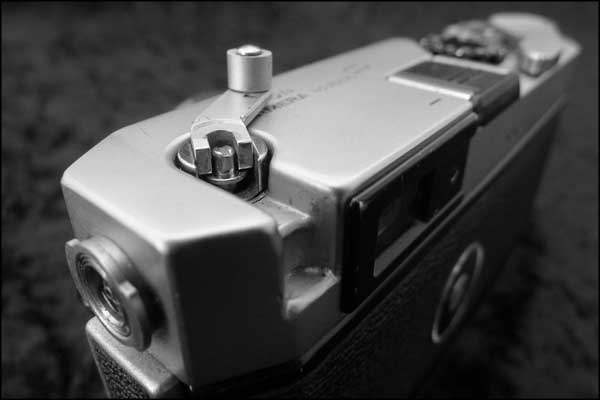
![]()
The Canon P has a standard Prontor/Compur (PC) Sync connector which
makes it very usable today, able to work perfectly with modern electronic
flashes and studio systems. The PC Sync port surround is designed to
lock on a vintage Canon flash bulb unit, which allowed flash use with
shutter speeds up to the camera's maximum of 1/1000s.
The rewind lever is a wonderful design that folds away when not in use.
The middle part has an orange line that turns as the film is wound on,
a useful indicator that the film is loaded correctly inside.
![]()
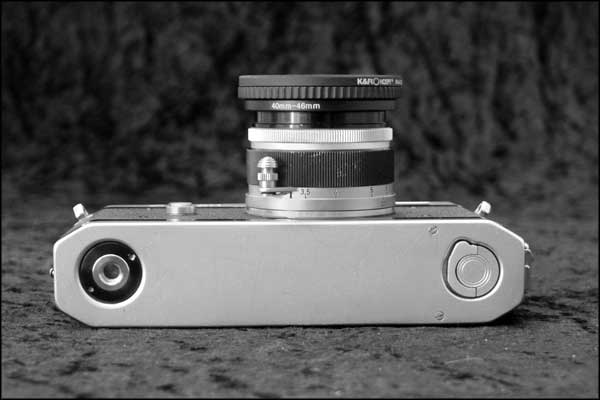
![]()
Although the Canon P has a swing open film door there are still elements
of the old traditional bottom loading system present... a non-central
tripod screw thread (although it is a contemporary 1/4 inch size) and
a lock that needs to be turned before the film door catch can be operated.
![]()
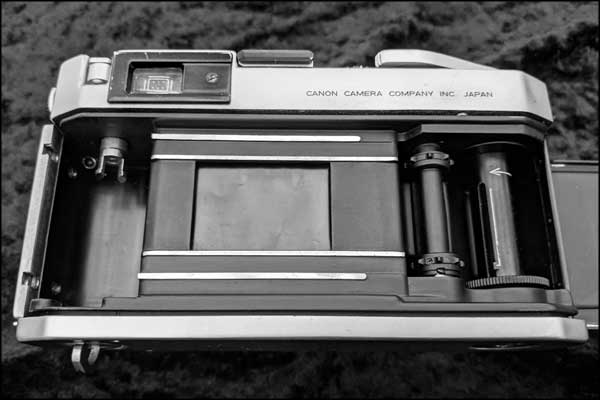
![]()
Compared with bottom loading cameras, this is much easier to load. The
shutter curtains are metal and it is usual to find them wrinkled but
this does not affect their operation. A major benefit of the metal shutter
is that the sun cannot burn holes into them, a common issue with the
cloth shutters found on the Leicas, and earlier Canons and Barnack copies.
![]()
Most swing open camera backs have a light-seal around them... not so
with the Canon P. Its design makes it light-tight without the need for
seals.
![]()
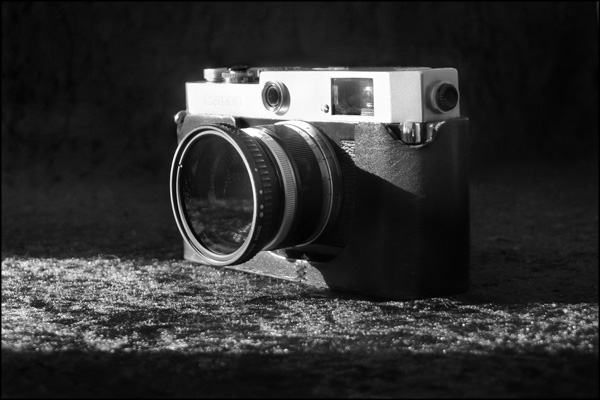
![]()
I have used my Canon P for work
and pleasure, live music shows, street and art photography, family holidays,
and as an everyday walkabout camera. I'd love to use it as my main camera
for absolutely everything but I have to admit there are issues that
stop me from doing so, especially in a professional capacity. The inability
to see exactly what the lens sees, the lack of an autofocus option...
it can be problematic at times. Of course there is a great advantage
to the immediate output and versatility of a digital camera, too. Even
though I feel great joy from using the Canon P I have to be sensible
about these things!
So as a favourite camera for personal street and documentary use it
really is pretty much everything I need, fun and rewarding to use, a
near perfect blend of style and function. I suppose it feels more personal
to me because I have customised it a little... the viewfinder dioptre
lens, half-case, and soft release shutter button but I wouldn't have
bothered had I not felt an instant affinity with this camera.
![]()
It feels an ideal size for my hand, it has absolutely no unnecessary
features, it is fully mechanical and precise, and manufactured to an
exceptionally high quality. It is quiet to use and despite being 60+
years old has contemporary features... modern tripods fit without adapters,
film doesn't need to be trimmed as it does for bottom loading cameras,
and it has a standard PC Sync port so modern flash systems work (wireless
flash on a vintage camera always raises an eyebrow or two!).
So, what does such a great camera cost? Well, a look on eBay for a Leica
M2 (body only) in good condition shows several ranging upwards of £1200.
A good Canon P will cost £150. My own one cost me £70 in
2015. I think it's been worth it.
![]()
![]()
![]()
Some favourites from the last roll of film...
![]()
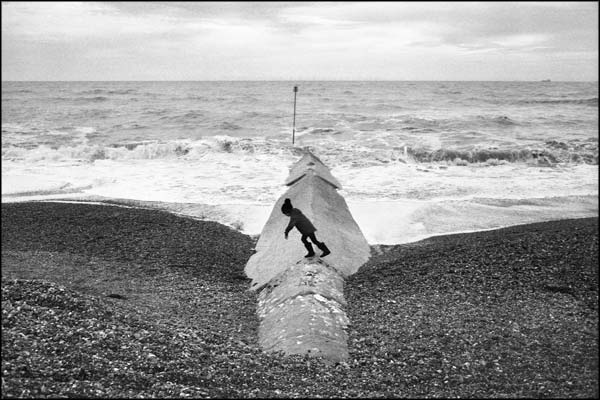
![]()
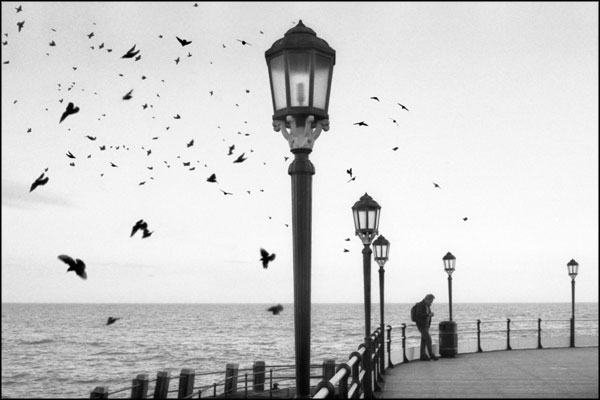
![]()
![]()
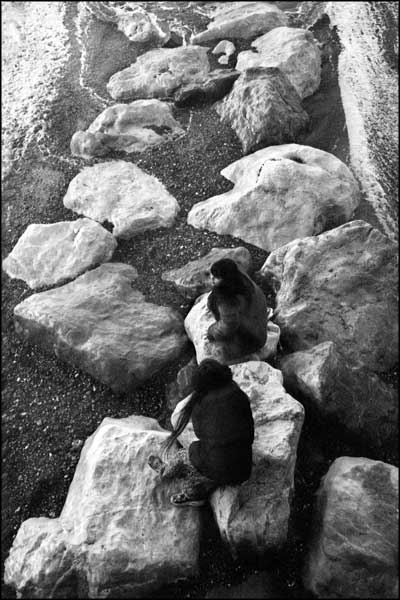
![]()
![]()
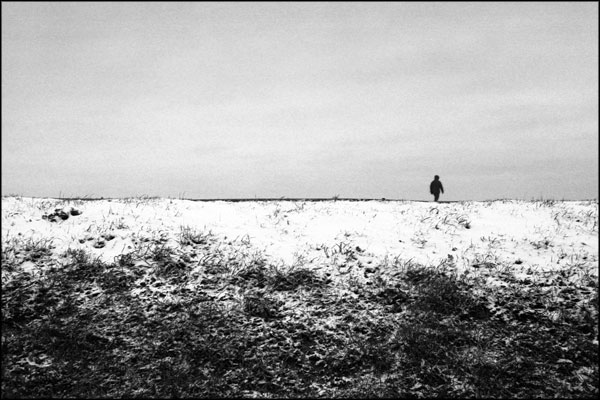
![]()
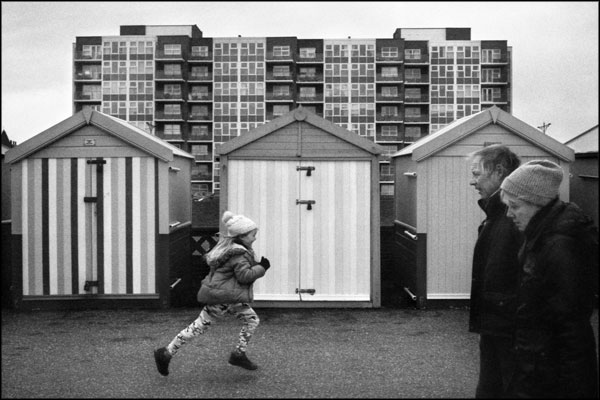
![]()
And some older examples...
![]()
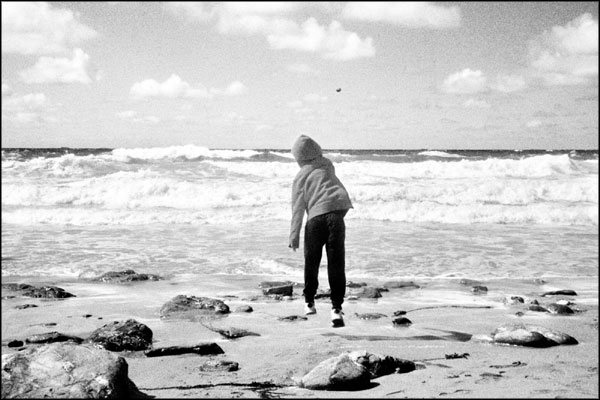
![]()
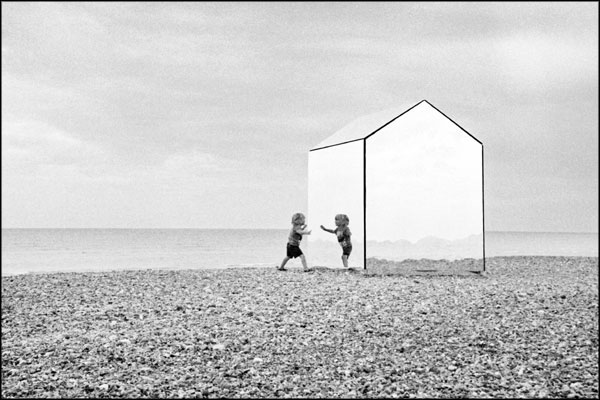
![]()
![]()
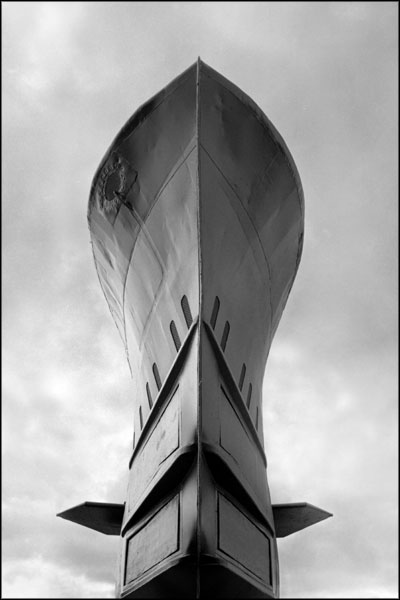
![]()
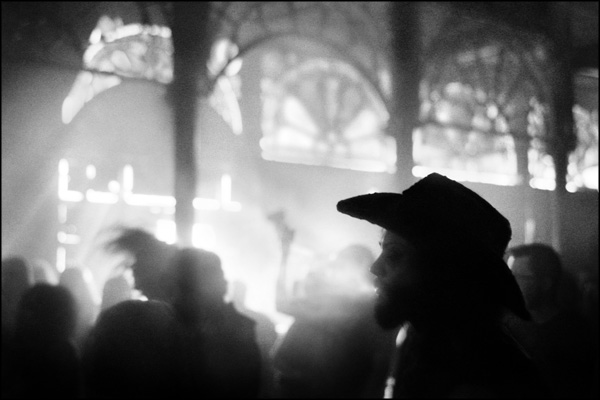
![]()
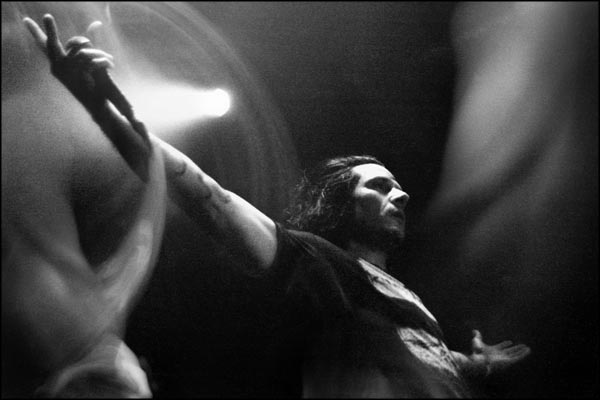
![]()
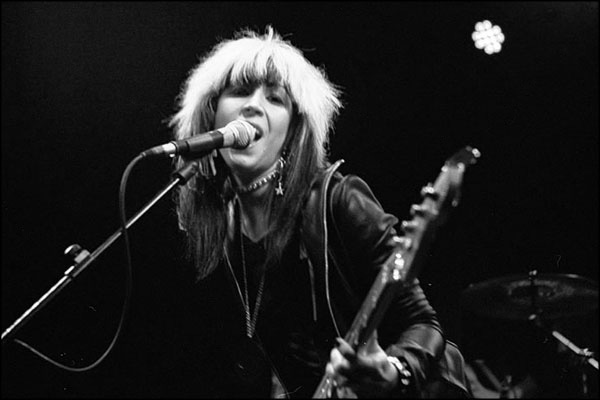
![]()
(Published 03/03/2021)
![]()
![]()
![]()
More posts...
![]()
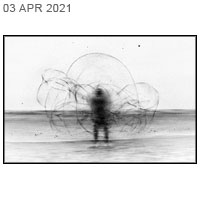
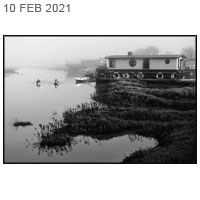
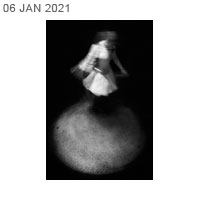
![]()
![]()
![]()
©
GREIG CLIFFORD.
ALL IMAGES ARE SUBJECT TO COPYRIGHT LAWS.
ALL RIGHTS RESERVED.
![]()